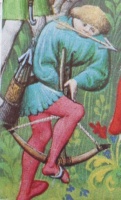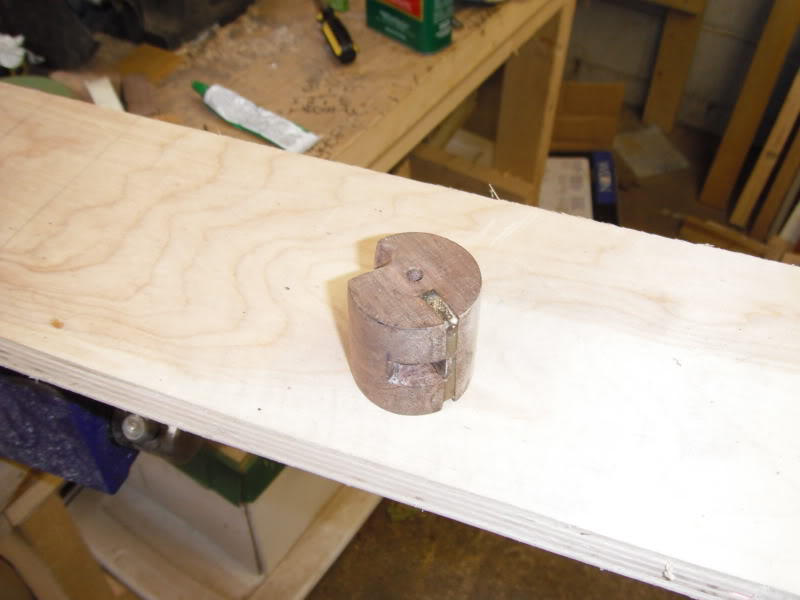Latest topics
» [solved]Skane/Lillohus crossbow thread
by stuckinthemud1 Sat Aug 10, 2024 3:16 pm
» Colletiere a Charavines continuing experiment
by stuckinthemud1 Fri Aug 02, 2024 7:13 am
» What you building?
by hullutiedemies Tue Jul 09, 2024 12:39 am
» 12th Century Chinese Crossbow Chronographed
by stuckinthemud1 Fri Nov 24, 2023 3:50 pm
» Crossbow Stock
by kenh Tue Oct 31, 2023 6:19 am
» Cocking - how
by stuckinthemud1 Thu Aug 03, 2023 4:24 am
» Questions around heavy crossbow lath buildin
by stuckinthemud1 Wed Apr 26, 2023 1:10 am
» Arab Crossbow
by stuckinthemud1 Tue Apr 25, 2023 7:57 am
» prod angle, and lever trigger for sale anyone?
by stuckinthemud1 Mon Mar 20, 2023 5:54 am
» flexible string
by jasper1978 Mon Mar 20, 2023 1:25 am
» jens sensfelder
by jasper1978 Wed Mar 08, 2023 11:58 pm
» 400lb Windlass crossbow bolts weight and accuracy shooting high.
by stuckinthemud1 Sun Mar 05, 2023 2:53 pm
» Codex Löffelholz crossbow
by stuckinthemud1 Tue Jan 24, 2023 4:14 pm
» Digitar prodsc
by stuckinthemud1 Sun Jan 15, 2023 2:42 pm
» Troubleshooting
by Andy. Fri Jan 06, 2023 12:29 pm
» Wood Prods
by stuckinthemud1 Fri Dec 30, 2022 12:47 pm
» Colletiere a Charavines crossbow
by stuckinthemud1 Fri Dec 30, 2022 8:54 am
» Simplified Löffelhotz speedloader
by stuckinthemud1 Fri Dec 09, 2022 4:05 pm
» Fiberglass H-bows
by c sitas Sat Nov 12, 2022 8:44 am
» Bad Antler
by drawknife Sat Nov 12, 2022 3:48 am
» Anyone make their own bolts?
by Juniper Mon Oct 17, 2022 8:20 am
» Josef alm in English
by Juniper Sat Oct 15, 2022 4:22 am
» Qin/Han lock drawings
by kenh Fri Sep 23, 2022 8:16 pm
» stirrup dimensions?
by stuckinthemud1 Thu Sep 01, 2022 1:49 pm
» Skane/Lillohus lockbow information needed
by stuckinthemud1 Sun Aug 14, 2022 6:23 am
by stuckinthemud1 Sat Aug 10, 2024 3:16 pm
» Colletiere a Charavines continuing experiment
by stuckinthemud1 Fri Aug 02, 2024 7:13 am
» What you building?
by hullutiedemies Tue Jul 09, 2024 12:39 am
» 12th Century Chinese Crossbow Chronographed
by stuckinthemud1 Fri Nov 24, 2023 3:50 pm
» Crossbow Stock
by kenh Tue Oct 31, 2023 6:19 am
» Cocking - how
by stuckinthemud1 Thu Aug 03, 2023 4:24 am
» Questions around heavy crossbow lath buildin
by stuckinthemud1 Wed Apr 26, 2023 1:10 am
» Arab Crossbow
by stuckinthemud1 Tue Apr 25, 2023 7:57 am
» prod angle, and lever trigger for sale anyone?
by stuckinthemud1 Mon Mar 20, 2023 5:54 am
» flexible string
by jasper1978 Mon Mar 20, 2023 1:25 am
» jens sensfelder
by jasper1978 Wed Mar 08, 2023 11:58 pm
» 400lb Windlass crossbow bolts weight and accuracy shooting high.
by stuckinthemud1 Sun Mar 05, 2023 2:53 pm
» Codex Löffelholz crossbow
by stuckinthemud1 Tue Jan 24, 2023 4:14 pm
» Digitar prodsc
by stuckinthemud1 Sun Jan 15, 2023 2:42 pm
» Troubleshooting
by Andy. Fri Jan 06, 2023 12:29 pm
» Wood Prods
by stuckinthemud1 Fri Dec 30, 2022 12:47 pm
» Colletiere a Charavines crossbow
by stuckinthemud1 Fri Dec 30, 2022 8:54 am
» Simplified Löffelhotz speedloader
by stuckinthemud1 Fri Dec 09, 2022 4:05 pm
» Fiberglass H-bows
by c sitas Sat Nov 12, 2022 8:44 am
» Bad Antler
by drawknife Sat Nov 12, 2022 3:48 am
» Anyone make their own bolts?
by Juniper Mon Oct 17, 2022 8:20 am
» Josef alm in English
by Juniper Sat Oct 15, 2022 4:22 am
» Qin/Han lock drawings
by kenh Fri Sep 23, 2022 8:16 pm
» stirrup dimensions?
by stuckinthemud1 Thu Sep 01, 2022 1:49 pm
» Skane/Lillohus lockbow information needed
by stuckinthemud1 Sun Aug 14, 2022 6:23 am
+12
8fingers
jopsa
Todd the archer
goody66
mac
Tinker
Pavise
Paulius
kiwijim
Ivo
Geezer
Moon
16 posters
Roller nut material

Moon- Techno Weeny
Lets put a laser on it!!!

- Posts : 55
Join date : 2010-02-25
- Post n°1
 Roller nut material
Roller nut material
What is recognized as the most durable roller nut material? What do you use and why? Thanks!

Geezer- Master Crossbowyer

- Posts : 1194
Join date : 2010-01-12
Age : 76
Location : Austin, Texas, USA
- Post n°2
 nut material
nut material
The traditional crossbow nut material of choice is bone or antler. I have found American moose-horn to be superior to any other. European moose are a slightly different breed, a bit closer to elk, so may not be as useful... I wouldn't know. Large American elk-horns are nearly useless... much too pithy, even at the very base. The base and stem of American moose is wonderfully hard stuff with almost no pith at all. Parts of the palm of the moose-horn (around the edges) are also very hard and make good reinforces for the nut socket. If you're building traditional medieval bows, I can't recommend moose too highly. Others, like Axis stag are also very hard, but it's much harder to get large pieces. Geezer

Moon- Techno Weeny
Lets put a laser on it!!!

- Posts : 55
Join date : 2010-02-25
- Post n°3
 How about synthetic materials
How about synthetic materials
Like certain types of Delrin?

Geezer- Master Crossbowyer

- Posts : 1194
Join date : 2010-01-12
Age : 76
Location : Austin, Texas, USA
- Post n°4
 Roller nut material
Roller nut material
Oh, I thought you were asking about the Best material. I use Delrin alla time in my less expensive bows. Have also used Hydex. They work great, at least up to the limits I build to... which is @ 200 lb. Geezer

Moon- Techno Weeny
Lets put a laser on it!!!

- Posts : 55
Join date : 2010-02-25
- Post n°5
 Geezer
Geezer
So there are acceptable materials that could easily handle 180 lb draw crossbows?
Thanks
Thanks

Geezer- Master Crossbowyer

- Posts : 1194
Join date : 2010-01-12
Age : 76
Location : Austin, Texas, USA
- Post n°6
 acceptable materials?
acceptable materials?
Yes, see above. Geezer

Ivo- Admin

- Posts : 1041
Join date : 2009-11-25
Age : 36
Location : NJ, USA
- Post n°7
 Re: Roller nut material
Re: Roller nut material
Roll-nut material is a cool topic, we've actually talked about this a little while back...it ranged from wood - to composites - to metals and their alloys...in fact I've actually cast one in soda can Aluminum for this fat little German I'm working on. 
Enjoy the read.

https://thearbalistguild.forumotion.com/design-discussion-construction-help-f12/roller-nut-material-t92.htm
Enjoy the read.
https://thearbalistguild.forumotion.com/design-discussion-construction-help-f12/roller-nut-material-t92.htm

kiwijim- Tinkerer
If there is a will, there is a way.

- Posts : 62
Join date : 2009-12-10
- Post n°8
 Re: Roller nut material
Re: Roller nut material
Were rollernuts ever commonly made from antler?
I'm sure that if you were a medieval arbalist and had access to moose antler, or ivory , you would use it.
But....
I have begun to think that the use of antler for the roller nut may be a misunderstanding on our part.
Let me explain...
The largest common deer in for most of Europe was and is the red deer. I have never found a red deer antler that was not pithy all the way to the coronet and unsuitable for a solid nut. (and I have cut up some laaarrrge antlers in an effort to extract a usable nut.)
Instead I think that arbalists may have used the bone protrusion from the skull from which the antler grow. I have used it. It is incredibly dense and hard; much stronger than average bone. Infact, with handtools, it is harder to work than antler! Also the skull of an average red stag will yeild two nuts with an outside diameter of at least 1.25" x 1.4" wide. Usually larger.
So, I think that maybe rollernuts were not commonly made from antler, but rather the skull directly below the antler.
Your thoughts appreciated.
James
I'm sure that if you were a medieval arbalist and had access to moose antler, or ivory , you would use it.
But....
I have begun to think that the use of antler for the roller nut may be a misunderstanding on our part.
Let me explain...
The largest common deer in for most of Europe was and is the red deer. I have never found a red deer antler that was not pithy all the way to the coronet and unsuitable for a solid nut. (and I have cut up some laaarrrge antlers in an effort to extract a usable nut.)
Instead I think that arbalists may have used the bone protrusion from the skull from which the antler grow. I have used it. It is incredibly dense and hard; much stronger than average bone. Infact, with handtools, it is harder to work than antler! Also the skull of an average red stag will yeild two nuts with an outside diameter of at least 1.25" x 1.4" wide. Usually larger.
So, I think that maybe rollernuts were not commonly made from antler, but rather the skull directly below the antler.
Your thoughts appreciated.
James

Paulius- Fresh Blood
Doesn't mean
I'm new to crossbows
- Posts : 20
Join date : 2010-06-03
Location : Lithuania
- Post n°9
 Re: Roller nut material
Re: Roller nut material
You could imagine how many deers would be needed for mass production crossbows if roller nuts were made only from deer skulls. Its just inefficient, so crossbow makers used whole antler, despite it is somewhat weaker than parts of skull below antlers. Broken nuts were just replaced with new ones.
The biggest nut found in Lithuania is 40 mm in diameter, and smallest 31 mm, so i believe that in medieval times there were deers with big enough antlers to make lots of crossbow nuts .
.
Paulius
The biggest nut found in Lithuania is 40 mm in diameter, and smallest 31 mm, so i believe that in medieval times there were deers with big enough antlers to make lots of crossbow nuts
Paulius

kiwijim- Tinkerer
If there is a will, there is a way.

- Posts : 62
Join date : 2009-12-10
- Post n°10
 Re: Roller nut material
Re: Roller nut material
Hi Paulius
I know what I am saying goes against the accepted dogma and maybe the antler stem was commonly used for roller nuts, but I am not so convinced.
In all my library and all my internet searches I have yet to see an image of a old nut that shows the pithy centre that you find in a deer antler. All the nuts I have seen are solid; so I conclude that they are either made from ivory (which was expensive) the base of moose antler (which was probably rare) or maybe bone?
I dont think finding miltary numbers of deer skulls would be too difficult. For example the English Royal household killed hundreds of deer every year for meat in organised drives in the New Forest. 500 hundred average stags would give you appox 1000 nuts.
Nor do I think that you would go to all the trouble of making a crossbow, maybe with a horn composite prod, and then install an inferior nut. Using such a nut in battle could be suicide, and on the hunt embarassing.
Regards
JAmes
I know what I am saying goes against the accepted dogma and maybe the antler stem was commonly used for roller nuts, but I am not so convinced.
In all my library and all my internet searches I have yet to see an image of a old nut that shows the pithy centre that you find in a deer antler. All the nuts I have seen are solid; so I conclude that they are either made from ivory (which was expensive) the base of moose antler (which was probably rare) or maybe bone?
I dont think finding miltary numbers of deer skulls would be too difficult. For example the English Royal household killed hundreds of deer every year for meat in organised drives in the New Forest. 500 hundred average stags would give you appox 1000 nuts.
Nor do I think that you would go to all the trouble of making a crossbow, maybe with a horn composite prod, and then install an inferior nut. Using such a nut in battle could be suicide, and on the hunt embarassing.
Regards
JAmes

Geezer- Master Crossbowyer

- Posts : 1194
Join date : 2010-01-12
Age : 76
Location : Austin, Texas, USA
- Post n°11
 deerskull nut?
deerskull nut?
Kiwijim mentions making roller nuts from the very hard bone at the base of the antler. I have seen at least one source that agrees on this point... no I don't remember who said that... maybe Payne-Gallwey? Josef Alm?
So yes, I think that's a possibility. I also wonder if the hard knob-end of legbones from horses or cattle... might be large and hard enough. It has to bear a lot of load. Guess I'll just have to find such a bone and cut it up for looksee. I've got some elk-legs curing under sand in the back yard. Maybe they'll tell me something.
As far as antler is concerned, some antlers are pithier than others, but I can't recall ever seeing a real medieval/renaissance crossbow with a pithy roller. If have made a few by drilling out the pith and replacing it with a piece of hardwood dowel, but wouldn't do that on a strong bow. Geezer.
So yes, I think that's a possibility. I also wonder if the hard knob-end of legbones from horses or cattle... might be large and hard enough. It has to bear a lot of load. Guess I'll just have to find such a bone and cut it up for looksee. I've got some elk-legs curing under sand in the back yard. Maybe they'll tell me something.
As far as antler is concerned, some antlers are pithier than others, but I can't recall ever seeing a real medieval/renaissance crossbow with a pithy roller. If have made a few by drilling out the pith and replacing it with a piece of hardwood dowel, but wouldn't do that on a strong bow. Geezer.

Moon- Techno Weeny
Lets put a laser on it!!!

- Posts : 55
Join date : 2010-02-25
- Post n°12
 I'm looking to find the very best
I'm looking to find the very best
man made material for roller nuts and also a drop in housing similar to tinkers. I won't be able to do much until January because I can't stay out of the woods during hunting season. I intend on building a practical hunting medieval similar in size and shape as the Maximilian I know have. I will be in touch with several plastics manufacturers.

Paulius- Fresh Blood
Doesn't mean
I'm new to crossbows
- Posts : 20
Join date : 2010-06-03
Location : Lithuania
- Post n°13
 Re: Roller nut material
Re: Roller nut material
Here you can see some photos of roller nuts found in Vilnius : http://www.lietuvospilys.lt/index-en.htm
Go to "finds" and then "kauliniai dirbiniai". Also there is a photo of bolt holder made from bone.
In my source it is written that whole antler was used to make nuts (there are some antler parts with saw marks found in place, where crossbows were manufactured). But nuts in photos seems to be without pith, so maybe you are right about bone, James.
Go to "finds" and then "kauliniai dirbiniai". Also there is a photo of bolt holder made from bone.
In my source it is written that whole antler was used to make nuts (there are some antler parts with saw marks found in place, where crossbows were manufactured). But nuts in photos seems to be without pith, so maybe you are right about bone, James.

Pavise- Dear Friend, You will be Greatly Missed.

- Posts : 128
Join date : 2010-02-07
- Post n°14
 Re: Roller nut material
Re: Roller nut material
"In days of old when men were bold and plastics weren't invented. They made their nuts from antler bone and went to war contented."
Just thought I'd let you guys know about the huge deer that once ranged throughout Britain and part of Europe. If you don't believe me then I suggest you take a look at the ones which the Natural History Museum have on display at their branch museum in a town called Tring in Hertfordhire. Those antlers are well over six feet across and make an elk's (wapiti) look small. Perhaps Tod knows of them; he's not too far from there.
Pavise
If only I were Tinker's grandfather eh. Wow!
Just thought I'd let you guys know about the huge deer that once ranged throughout Britain and part of Europe. If you don't believe me then I suggest you take a look at the ones which the Natural History Museum have on display at their branch museum in a town called Tring in Hertfordhire. Those antlers are well over six feet across and make an elk's (wapiti) look small. Perhaps Tod knows of them; he's not too far from there.
Pavise
If only I were Tinker's grandfather eh. Wow!

Tinker- Techno Weeny Supreme

- Posts : 75
Join date : 2010-07-19
Location : Idaho, USA
- Post n°15
 Still here Pavise
Still here Pavise
If only I were Tinker's grandfather eh. Wow!
No Kidding; My Grandpa used to tell me of how the Woolly mammoth tusks were laying around outside his cave thicker'n fleas on his dog's back


Moon- Techno Weeny
Lets put a laser on it!!!

- Posts : 55
Join date : 2010-02-25
- Post n°16
 wouldn't that at least
wouldn't that at least
be your great grandpa?
I didn't know there were so many different Delrin materials. I'm going to be digging up as much info as I can before January. I hope to build 2 crossbows early next year. I like Tinker's idea of a drop in module for the tickler/roller nut. I will be installing safeties on these hunting crossbows. Don't know yet if I can get that in the module or not but I'm going to try.
I didn't know there were so many different Delrin materials. I'm going to be digging up as much info as I can before January. I hope to build 2 crossbows early next year. I like Tinker's idea of a drop in module for the tickler/roller nut. I will be installing safeties on these hunting crossbows. Don't know yet if I can get that in the module or not but I'm going to try.

Tinker- Techno Weeny Supreme

- Posts : 75
Join date : 2010-07-19
Location : Idaho, USA
- Post n°17
 Re: Roller nut material
Re: Roller nut material
No, MOON, My Grandpabe your great grandpa?

Jim Koch (Alchem) sells a nut/roller he calls "ABS". I don't know what it is, but it sure does not work like the black nylon/Delrin block or any other nylon I have dealt with. Maybe it could be best described as a little softer maybe and oily; but it obviously isn't oily. That sounds stupid but that is my take on it. I tried to use a band saw for shallow cutting of the string notch but it wants to melt. Luckily, I was allowing plenty of working room. It machines well with a slower milling cutter. For a string cut-out I would use a hacksaw and very sharp (small) wood gouges. I found it works well with sharp rounded gouges and making minute cuts.
You undoubtedly noticed the threaded sear extends as a stop on that one. If it does not have that stop installed it will most probably no longer be captive when the string notch passes the front edge of the module block. You might find yourself crawling around the underbrush looking for your nut so's Bambi can be finished-off
If there is no sear stop, a center pin running through the stock would prevent that... But getting it located dead-on so as not to cause binding might be tough! I'm sure if you set your mind to it you can make that block utilize a number of different 'safties'.
Tinker

Moon- Techno Weeny
Lets put a laser on it!!!

- Posts : 55
Join date : 2010-02-25
- Post n°18
 The arrow retention finger/spring
The arrow retention finger/spring
will prevent the roller nut from coming all the way out. For hunting, I will use a much longer finger with more stiffness to help prevent the arrow from being knocked off the arrow groove.
I'll probably end up using a black Delrin material for the RN and body. I will radius the 4 corners of the RN/trigger body so I won't have to inlet square corners in the stock. I don't want to use side plates because I'll be using a rope cocker. I'm using one now on the 160 lb draw Maximilian and it's nice. I'm hoping to end up with a 180 lb prod on the "Moon" medieval but we shall see how it works out. I'll probably use straight grain walnut for the stock with a linseed oil finish.
Lots to learn but I'm looking forward to it.
I'll probably end up using a black Delrin material for the RN and body. I will radius the 4 corners of the RN/trigger body so I won't have to inlet square corners in the stock. I don't want to use side plates because I'll be using a rope cocker. I'm using one now on the 160 lb draw Maximilian and it's nice. I'm hoping to end up with a 180 lb prod on the "Moon" medieval but we shall see how it works out. I'll probably use straight grain walnut for the stock with a linseed oil finish.
Lots to learn but I'm looking forward to it.

Pavise- Dear Friend, You will be Greatly Missed.

- Posts : 128
Join date : 2010-02-07
- Post n°19
 Re: Roller nut material
Re: Roller nut material
ABS stands for Acrylonitrile-Butadiene-Styrene which is an engineering class of plastic typically used for the manufacturing of cases for electronic devises. e.g. computer covers, machined prototypes, support blocks and structural components. And I don’t think that Jim Koch would be selling and using something that is unsuitable for the job. However when choosing any material for a crossbow release nut, we must be aware of what we are asking that nut to do!
Unlike most metals, plastics generally have what is known as “creep modulus”. This is where under strain and stress the plastic can deform, and if severe enough fail; sometimes with catastrophic results. The point at which the crossbow string engages the claws is relatively close to the centre of the given rolling-nut and so the claws are more in shear than in tension when the crossbow is spanned. But it behoves us all to be cognisant of the fact that perhaps in excess of 200 lbs can be held back by “plastic material” and the small area behind the metal sear embedded in that material. Heat is a typical enemy of such parts, as well as in some, an affinity to moisture, and of course to be effected by extreme cold. White or beige coloured plastics are often chosen because they serve to replicate natural materials such as bone, antler or ivory, thus giving a pleasing look to the finished crossbow. Some plastics have lubricity characteristics which are desirable inasmuch as they work without added lubricants in an application such as a crossbow nut forced to turn under extreme load whilst being confined in its socket. The bearing surfaces in our crossbow application are quite large in order to carry the load demanded by the builder and there should be no binding as one surface slides over the other.
I could write another page on this subject alone but rather than appear as a know-all I will simply ask that you do some critical research before deviating from proven designs and materials; many of which are already well covered by other experts within the pages of this forum.
Pavise
Unlike most metals, plastics generally have what is known as “creep modulus”. This is where under strain and stress the plastic can deform, and if severe enough fail; sometimes with catastrophic results. The point at which the crossbow string engages the claws is relatively close to the centre of the given rolling-nut and so the claws are more in shear than in tension when the crossbow is spanned. But it behoves us all to be cognisant of the fact that perhaps in excess of 200 lbs can be held back by “plastic material” and the small area behind the metal sear embedded in that material. Heat is a typical enemy of such parts, as well as in some, an affinity to moisture, and of course to be effected by extreme cold. White or beige coloured plastics are often chosen because they serve to replicate natural materials such as bone, antler or ivory, thus giving a pleasing look to the finished crossbow. Some plastics have lubricity characteristics which are desirable inasmuch as they work without added lubricants in an application such as a crossbow nut forced to turn under extreme load whilst being confined in its socket. The bearing surfaces in our crossbow application are quite large in order to carry the load demanded by the builder and there should be no binding as one surface slides over the other.
I could write another page on this subject alone but rather than appear as a know-all I will simply ask that you do some critical research before deviating from proven designs and materials; many of which are already well covered by other experts within the pages of this forum.
Pavise

Moon- Techno Weeny
Lets put a laser on it!!!

- Posts : 55
Join date : 2010-02-25
- Post n°20
 Thanks
Thanks
I am staying with the dimensions of existing roller nuts being used and I don't plan on going heavier than 180 lb draw weight. I will be doing my homework and asking lots of questions from plastics suppliers and manufacturers. I do want to use a grey or black material for the roller nut and deck inlay for hunting purposes.
I also intend on working with an inexpensive wood test "mule" stock/tiller to determine the viability of the parts before ever putting them in the final walnut stock.
I also intend on working with an inexpensive wood test "mule" stock/tiller to determine the viability of the parts before ever putting them in the final walnut stock.

mac- Master Weaponsmith

- Posts : 561
Join date : 2010-12-23
Location : Near Philly USA
- Post n°21
 Re: Roller nut material
Re: Roller nut material
kiwijim wrote:Were rollernuts ever commonly made from antler?
I'm sure that if you were a medieval arbalist and had access to moose antler, or ivory , you would use it.
But....
I have begun to think that the use of antler for the roller nut may be a misunderstanding on our part.
Let me explain...
The largest common deer in for most of Europe was and is the red deer. I have never found a red deer antler that was not pithy all the way to the coronet and unsuitable for a solid nut. (and I have cut up some laaarrrge antlers in an effort to extract a usable nut.)
Instead I think that arbalists may have used the bone protrusion from the skull from which the antler grow. I have used it. It is incredibly dense and hard; much stronger than average bone. Infact, with handtools, it is harder to work than antler! Also the skull of an average red stag will yeild two nuts with an outside diameter of at least 1.25" x 1.4" wide. Usually larger.
So, I think that maybe rollernuts were not commonly made from antler, but rather the skull directly below the antler.
Your thoughts appreciated.
James
James,
That is a very interesting idea you have had. Deer pedicles are truly remarkable for their density and hardness. I have used ones from white tail deer to make gaming dice, and the results are like the best modern plastic dice. If the pedicles were big enough, I am sure that they would make good nuts.
I wonder how we could tell if the nuts we find on old bows were really made of pedicle rather than antler. Have you actually turned any of them into nuts? Are there any tell tale anatomical feartures that show up when this material is turned?
Mac

mac- Master Weaponsmith

- Posts : 561
Join date : 2010-12-23
Location : Near Philly USA
- Post n°22
 Re: Roller nut material
Re: Roller nut material
Geezer wrote: The traditional crossbow nut material of choice is bone or antler. I have found American moose-horn to be superior to any other. European moose are a slightly different breed, a bit closer to elk, so may not be as useful... I wouldn't know. Large American elk-horns are nearly useless... much too pithy, even at the very base. The base and stem of American moose is wonderfully hard stuff with almost no pith at all. Parts of the palm of the moose-horn (around the edges) are also very hard and make good reinforces for the nut socket. If you're building traditional medieval bows, I can't recommend moose too highly. Others, like Axis stag are also very hard, but it's much harder to get large pieces. Geezer
Geezer,
I agree with you about the excellent qualities of moose antler for nuts, and I have some good news.
The North American moose is the same species of animal as the Eurasian elk. They are both Alces alces. The confusion arises from us folks in North America calling the wapiti (Cervus canidensis) an "elk". This article gives an overview http://en.wikipedia.org/wiki/Moose
There are several sub species, or races, but I am confident that their antlers are fundamentally the same.
Mac.
asd

goody66- Fresh Blood
Doesn't mean
I'm new to crossbows
- Posts : 2
Join date : 2011-02-03
Age : 58
Location : Salem VA
- Post n°23
 Lignum Vitae ?
Lignum Vitae ?
Has anyone here ever used Liqnum Vitae for rollernuts? I just happened into a small piece, probably enough for 2 or 3 rollernuts.

mac- Master Weaponsmith

- Posts : 561
Join date : 2010-12-23
Location : Near Philly USA
- Post n°24
 Re: Roller nut material
Re: Roller nut material
I'm sure that lignum vitae will work better than most woods. It's a question of how strong a bow you are thinking of. David Watson ("geezer" on this forum) has a lot of experience with wooden nuts. Perhaps he can suggest some design parameters for you.
Mac
Mac

Todd the archer- Crossbow Junkie
I live here!

- Posts : 581
Join date : 2010-02-25
Age : 62
Location : sellersville,pa.
- Post n°25
 Re: Roller nut material
Re: Roller nut material
I do not know about that wood. I have used Walnut. Made it 1 1/2" diameter and 1 1/2" wide. Wider than most I suspect, but figured being made from wood the extra width makes it stronger. This one I used on my 157 pound crossbow:

Todd

Todd


 Private messages
Private messages